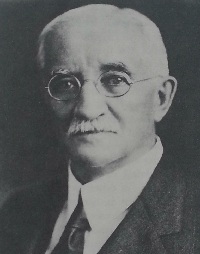Arthur N. Talbot

Biography
Arthur N. Talbot
Teacher – Author – Researcher – Consultant
Railways – Highways – Water Control – Sanitation – Municipal Engineering – Structural Materials
Fourth National Honor Member Nominated by the University of Illinoi Chapter
At a time when concrete was a novelty introduced initially by the French, Arthur Newell Talbot was a true pioneer in its development as a structural material in the United States. His span of life – 1857 -1942 – was destined to embrace many such developments; and during his professional life – sixty-one years, beginning with his graduation from the University of Illinois in 1881 – he was ever busy promoting many of those developments, and in perpetuating his findings based on practical experience, in the technical literature of his day. He produced more than 400 articles and bulletins. Among the best known of these are his book, “The Railway Transition Spiral,” the ASCE Committee reports on “Stresses in Railroad Tract,” and the Talbot formulas for the area of waterways for designing bridges and culverts and for rates of rainfall. A great mass of his research records appear in the blanket anonymity of other committee reports, which serves to demonstrate the true greatness of an honestly modest professional man.
Born at Cortland, Illinois, on October 21, 1857, he was graduated from the University of Illinois in 1885 and received his professional degree of civil engineer in 1887. He then undertook his first engineering work in the railway field, with the Denver and Rio Grande, the Atchison, Topeka and Santa Fe, and the Northern Pacific. For forty-one years, he was a member of the faculty at the University of Illinois, beginning as an assistant professor and ending as a world-renowned consultant in all the many facets of his chosen field.
He died in Chicago, April 3, 1942, at the age of 84 years. Professor Talbot did his pioneer work in plane and reinforced concrete and other structural materials, and his research in railroad tract stresses led to the present day railway right-of-way. For 36 years, he was in charge of the Department of Theoretical and Applied Mechanics at the university and, in 1903, he helped to establish the University of Illinois Engineering Experiment Station, the first of its kind in the United States. His monument, an inspiration to all members of the Fraternity, is the Arthur Newell Talbot Materials Laboratory dedicated at the university in 1938.
Arthur Newell Talbot was the recipient of many engineering honors, including honorary doctorates from the Universities of Pennsylvania, Michigan, and Illinois, the John Fritz Medal, the Washington Award, the Henderson Medal, and the Lamme Medal. His engineering affiliations included honorary membership in the American Society for Testing Materials, the Western Society of Engineers, the American Railway Engineers Association, the American Concrete Institute, and the American Society of Civil Engineers. He served with distinction in many ASCE offices-as director, vice-president and president. He was elected to honorary membership in the society in 1925.
The University of Illinois chapter of Chi Epsilon elected him as a Chapter Honor Member in May, 1926, and the Fraternity elevated him to the grade of National Honor Member in early April, 1932. Quoting chapter minutes for March 31, 1932: “… Brother Wissmuller reported that Professor A. N. Talbot had been elected by the Supreme Council to national honorary membership, but had not yet given his acceptance.” The chapter minutes for April 10, 1932 state, in part: “… The initiation banquet was held at 5: 30 p.m. at the Inman Hotel (in Champaign, Illinois) … at which time he “was presented a key and (the grade of) National Honor Member in Chi Epsilon.” Members will remember best that although qualified to wear an imposing array of honor keys across his vest, he displayed only one of these – Transit of Chi Epsilon Fraternity.



